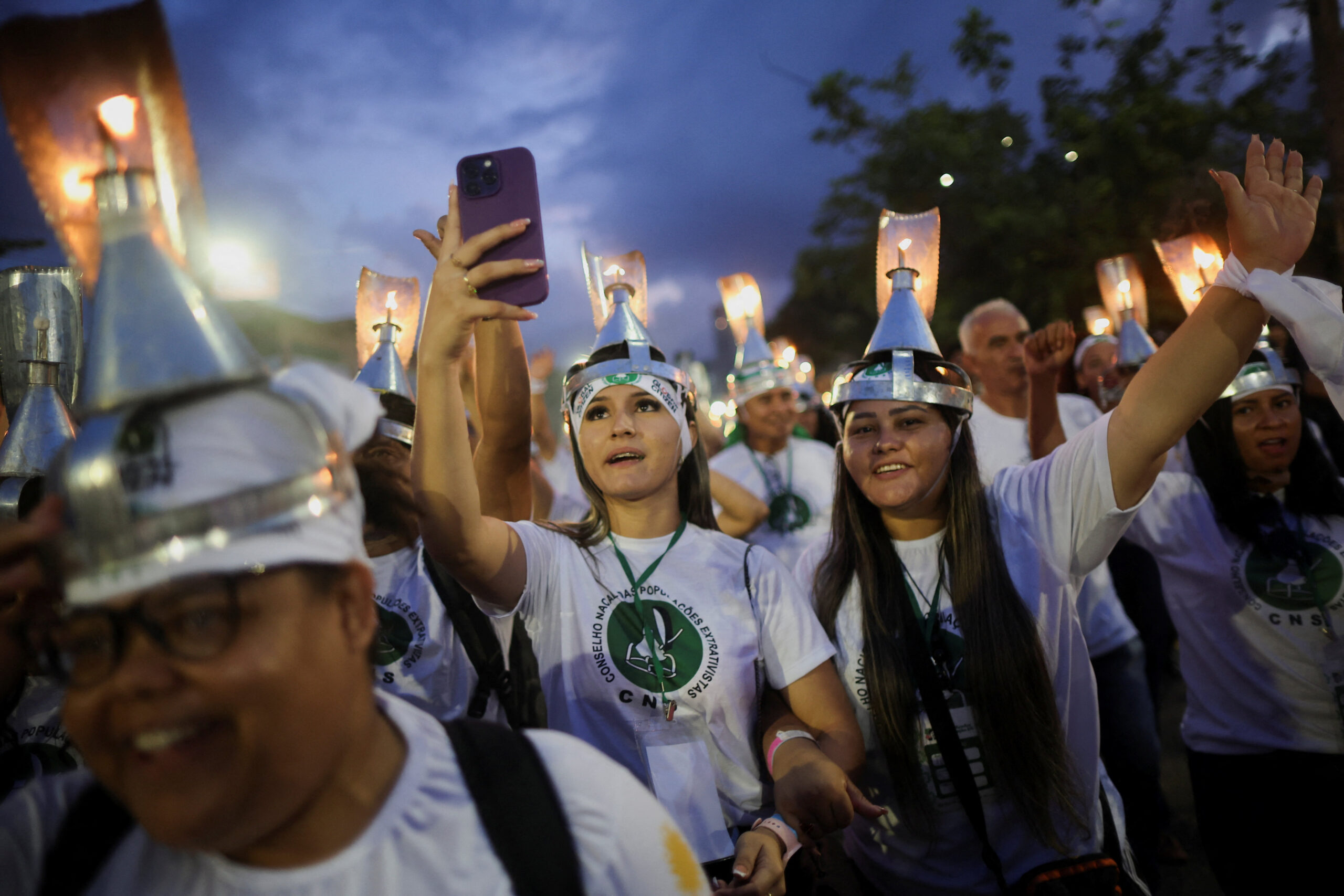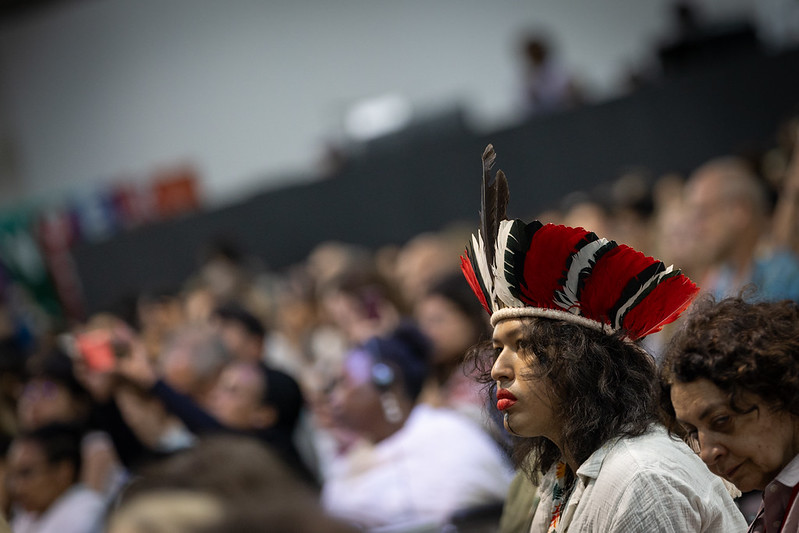Welcome to Carbon Brief’s DeBriefed.
An essential guide to the week’s key developments relating to climate change.
This week
Floods and fires
PAKISTAN FLOODS: Torrential rain in northern Pakistan killed almost 400 people over five days, Agence-France Press reported. The rains have caused flooding and landslides that have “swept away entire villages, leaving many residents trapped in the rubble and scores missing”, it added. Bloomberg reported that the monsoon season has killed at least 1,860 people in India and Pakistan, “with flash floods, landslides and inundated cities exposing the region’s growing vulnerability to climate-related disasters”.
HEAVY RAIN IN CHINA: In China’s Inner Mongolia province, 13 people have been killed in floods caused by heavy rains, reported Reuters. It added that “heavy rainfall and severe floods that meteorologists link to climate change” are posing “major challenges”, including “economic losses running into billions”.
SPANISH WILDFIRES: Spain has continued to battle several major wildfires, even as temperatures across the country began to drop, reported the Associated Press. The fires have burned a total area twice the size of London this year, added the Daily Telegraph. The emissions from the wildfires have “surged to their highest levels in at least 23 years”, reported the Independent.
Around the world
- TRUMP REPORT ‘IRREGULARITIES’: A former head at the US Environmental Protection Agency has requested a correction to a recent misleading climate report from the Department of Energy, citing “legal and procedural irregularities”, reported Politico.
- SOARING SOLAR: Solar power generation in Britain has already surpassed the total for 2024, with more than 14 terawatt hours of electricity produced as of 16 August, the Financial Times reported.
- ‘CLASH OF VIEWS’: Incoming president of the COP30 climate summit, Brazilian diplomat André Corrêa do Lago, is preparing for a “clash of views” over how countries should respond to a review of their overdue climate plans, according to Climate Home News.
- TAX CREDITS: The US treasury department has issued guidance that “narrows which wind and solar energy projects” can receive the remaining tax credits set to be “largely eliminated” by the Republicans’ “big beautiful bill”, reported the Hill.
195%
The record increase in UK renewable energy capacity to gain planning permission in the second quarter of this year, when compared to the same period in 2024, reported the Financial Times.
Latest climate research
- The risk of rice production failure across Indian districts could increase by 26%, on average, due to climate change by 2055-84 | Environmental Research Letters
- Newborns across 33 African countries are more likely to die if their mothers are exposed to extreme heat during pregnancy | PNAS Nexus
- More than 13,800 square kilometres of giant panda habitat could “degrade” under a moderate-warming scenario | Global Change Biology
(For more, see Carbon Brief’s in-depth daily summaries of the top climate news stories on Monday, Tuesday, Wednesday, Thursday and Friday.)
Captured

Clean-energy growth helped China’s carbon dioxide (CO2) emissions fall during the first half of the year, despite an increase in electricity demand, new analysis for Carbon Brief found. Emissions in the first half of the year fell by 1% year-on-year, extending a declining trend that started in March 2024, the analysis said. CO2 output fell in China’s power sector by 3%, with the growth in solar power alone matching the rise in electricity demand in the country. Emissions also fell in the building materials, steel and heating industries sectors, the analysis added.
Spotlight
How architecture can support climate-adaptive design
This week, Carbon Brief interviews Prof Alice Moncaster, professor of sustainable construction at the University of the West of England, about how architecture can adapt to the growing pressures of climate change.
Carbon Brief: What are the biggest challenges with designing climate-adaptive buildings?
Alice Moncaster: Climate change is already producing far more frequent and extreme heatwaves across most of the world, as well as more severe storms leading to flash flooding and failing roof and subsurface drainage systems, and long periods of drought, meaning water shortages and shrinking ground leading to cracking buildings.
There are two huge challenges for designing buildings that can physically withstand these extremes. The first is perhaps the easier, which is the design of new buildings. This is critical in developing nations where rapidly increasing and urbanising populations need a parallel expansion in their built environment.
The second is more complex and often seen as less exciting, but is essential to developed countries with a mature building stock and lower or no population growth – how to retrofit our existing buildings from all previous decades to withstand the new weather.
Really, there is a third, less talked about challenge. At the same time as designing and retrofitting for increasingly extreme climates, this major construction programme needs to add the very minimum to greenhouse gas emissions. We cannot just continue to throw money and materials at adaptation because, at the same time, we need to reduce our carbon emissions as much as possible in order to limit further climate change.
CB: There is a lot of focus on air conditioning (AC) currently, but how can the architectural design of a building also help to keep people cool in a warming climate?
AM: This is becoming a huge issue. AC not only uses energy, but adding portable AC units kicks heat out of the building, making the outside even hotter. Passive design strategies have existed for millennia in hotter countries.
These are focused on four approaches.
First, ventilation is increasingly an issue in countries where buildings are constructed to keep the warmth in and, therefore, are built to be airtight. A passive approach is to design in a stack or chimney effect, with an opening at the top of the building, often above a central atrium.
Second, the thermal inertia of a building has long been understood as essential for keeping buildings cool in hot summers. Rather than plasterboard, if wall or floor surfaces are exposed stone, brick or concrete, they will stay cool for many hours longer (as anyone who has been in an old church will know).
A method which combines ventilation with thermal inertia is a “jaali wall”, a perforated stone or brick screen used in some traditional Asian architecture.

Third, shading the outside of the building from the sun is essential. Many Mediterranean buildings include external shutters, which keep the sun off the windows.
The final approach is how the building is used. Bedroom spaces are often moved in hotter countries to cooler areas of the house or even outside.
CB: Do you think there is enough centering of climate-adaptive design within architectural practice currently?
AM: I believe that there is a huge amount of knowledge among our architects and building professionals about climate-adaptive – and climate-mitigating – design, but that it is very hard to make it actually happen.
I think it is partly due to the slow-to-change nature of the construction sector, across skills, materials and supply chains. But I increasingly think that underlying the sector are the powerful vested interests, which means that traditional materials still dominate.
Procurement practices also often do little to support innovation and the understanding of risk has not yet caught up with the very real risk of climate change.
Watch, read, listen
MASS EXTINCTION: A long read in the Guardian questioned whether climate change is leading towards “another Great Dying”.
A GOOD PLANET: On a New Scientist podcast, climate scientists Kate Marvel and Tim Lenton discussed how to fix climate change, quipping: “All of the other planets out there are just complete garbage. The Earth is the only good place.”
COOLED VS COOKED: A guest essay in the New York Times discussed the new American inequality – those who are “cooked” and those who are “cooled” – as extreme heat becomes increasingly common in the US.
Coming up
- 26-29 August: 6th Forum of Ministers and Environment Authorities of Asia Pacific, Fiji
- 24-28 August: World Water Week 2025, Stockholm, Sweden
- 27 August: UN Environment Programme sixth meeting of the open-ended ad hoc group on measurability and indicators, online
Pick of the jobs
- British Antarctic Survey, project manager – Rothera Renewable Energy | Salary: £56,509-£62,159. Location: Cambridge/Antarctica
- ClientEarth, UK environment lawyer | Salary: £56,991. Location: London
- The New York Times, deputy editor, climate desk | Salary: $150,000-$175,000. Location: Hybrid/New York
- Indigenous Climate Action, climate leadership coordinator | Salary: $55,000- $65,000. Location: Remote
- India Climate Collaborative, programme manager – heat | Salary: Unknown. Location: Mumbai/ Delhi/Bengaluru
DeBriefed is edited by Daisy Dunne. Please send any tips or feedback to debriefed@carbonbrief.org.
This is an online version of Carbon Brief’s weekly DeBriefed email newsletter. Subscribe for free here.
The post DeBriefed 22 August 2025: Pakistan floods; China emissions drop; Climate-adaptive architecture appeared first on Carbon Brief.
DeBriefed 22 August 2025: Pakistan floods; China emissions drop; Climate-adaptive architecture
Climate Change
Members of America’s Largest Power Grid Can’t Agree on How to Power Data Centers
With no consensus among stakeholders, PJM Interconnection’s 10-member board now must craft a policy for surging data-center demand that has already driven up electricity prices for millions.
After months of wrangling over how to handle surging power demand from AI-driven data centers and the resulting spike in electricity prices for millions, members of PJM Interconnection, the nation’s largest grid operator, could not agree on a solution.
Members of America’s Largest Power Grid Can’t Agree on How to Power Data Centers
Climate Change
“Coordinated backlash”: Activists say COP30 gender spat reflects wider threat
During the closing session of COP30, the representative of the Holy See – the governing body of the Vatican – was booed. That reaction was triggered by his statement requesting that any mentions of gender should be “understood as grounded on the biological sexual identity that is male and female”.
The comments followed a heated debate that had threatened to derail talks on the new Gender Action Plan (GAP) in Belém, stirring concerns that growing political pressure in the wider world to roll back advances on gender issues had seeped into the UN climate process.
Gender was a hotter-than-usual topic at this COP. Negotiators were tasked with agreeing a new GAP – a document to guide how gender features in climate decisions and action over the next 10 years, including balanced participation in climate talks, ensuring that climate projects consider different gender needs in their implementation, and collecting data that is broken down by gender.
Part of a broader work programme on gender, which was renewed during COP29, work on the GAP started at June’s mid-year talks in Bonn. That produced a text containing 99 brackets, denoting issues to be resolved. As disagreement among parties multiplied in Brazil, the last draft made public during COP30 had 496 brackets, making it a small miracle that a final version of the GAP was approved at the summit.
COP30 fails to land deal on fossil fuel transition but triples finance for climate adaptation
The most controversial issue was the definition of gender, which the Holy See, Argentina, Paraguay and Iran wanted to refer to as “biological sex”, reflecting their concerns about trans and non-binary people. One draft version of the text included a footnote added by each of those countries marking their objections. None of them made it into the final decision.
While Russia did not submit its own footnote, Climate Home News understands that it pushed hard to replace the term “gender” with “women and girls” and “men and boys”. During its intervention at the closing plenary, Russia’s delegate said his government works to strengthen the institution of marriage, which it understands as “a relationship between a man and a woman”.
Another thorny issue was “sexual and reproductive health”, a term that did not appear in the final text. The Holy See was among those that fought hard to exclude it. Archbishop Giambattista Diquattro, the head of delegation, said in an interview with Vatican News that tackling this topic was “a diversion from the real issue under discussion”, adding that “the inclusion in the text of sexual and reproductive rights, which include abortion”, is something the city-state could not “in any way accept.”
“Cruel” intrusion into climate debate
Partway through COP30, as the rows over gender surfaced, women’s rights organisations denounced the situation at a press conference.
“We’ve always had fights on the Gender Action Plan… but this is different. This is trying to actually push women back by having this binary definition,” said Mary Robinson, former Irish president who is now a member of the Elders. “It’s so cruel. I mean, it’s actually unbelievable that this would enter into our space.”


Bridget Burns, executive director of the Women’s Environment & Development Organization (WEDO), said it felt like a coordinated backlash – and it wasn’t limited to the gender negotiations.
Argentina and Paraguay also raised objections to definitions of gender in the Just Transition Work Programme (JTWP) negotiations. But they didn’t get what they wanted there either.
“The outcomes we got in the JTWP decision are the most ambitious from a rights and inclusion perspective ever,” said Anabella Rosemberg, senior advisor on just transition with Climate Action Network International, noting that the protestations by specific countries on gender would only be added to the UN climate summit’s report. “They didn’t get what they wanted, which was a footnote in each decision.”
Had that happened, it would have posed “a very serious threat to the process”, said Rosemberg. Burns said allowing definitions on what words mean for individual parties to creep into the formal decision texts could have set “a bad precedent”.
Claudia Rubio Giraldo, associate for policy and programmes at WEDO, said that such resistance to human rights language shows how important advocacy is – and advocacy groups should be ready to act when negotiation rooms that were previously “progressive points of discussion” become “battlegrounds” on human rights in climate action.

Nonetheless, noted Burns, this was the first time sexual and reproductive rights had entered a gender draft, albeit in brackets.
And she pointed to a deliverable in the final GAP document that asks governments to submit the findings of national assessments, including on “health, violence against women and girls, and care work in the context of gender and climate change”.
“We’re hopeful that [this] gives us the opportunity for countries who are making progress on this to actually share their solutions,” Burns added.
A GAP without money
On finance, however, campaigners were disappointed with the outcome. They had pushed for women to be given direct access to funding – and for gender to be addressed as part of the climate finance negotiations. Yet, even at a COP where one of the main wins was a tripling of finance for adaptation by 2035, there was little progress on funding for “gender-responsive” work.
Burns described the talks as “a massive failure” on that front. But she pointed to the COP29 decision to renew the Enhanced Lima Work Programme on Gender, which says that the Green Climate Fund, the biggest UN climate fund, should “strengthen the gender-responsiveness of climate finance”, and facilitate access to climate finance for grassroots women’s organisations.
In 2022, they received just 4% of government aid spent on adaptation. On mitigation efforts to reduce emissions, that number dropped to 2%.
Burns said advocacy groups will also push for finance across broader areas like tax, trade and debt to intersect with gender needs and unlock more funds for climate programmes targeted at women.
For now, she said, it is important to ensure COP30’s progress is protected and that the agreement on the GAP in Belém in allows for “focusing on solutions and ways in which we can both enhance climate action and gender equality without having to renegotiate our rights every single year”.
The post “Coordinated backlash”: Activists say COP30 gender spat reflects wider threat appeared first on Climate Home News.
“Coordinated backlash”: Activists say COP30 gender spat reflects wider threat
Climate Change
County Planning Commission in Virginia Delays Vote Again on Proposed Gas Plant That Aims to Link to PJM Grid
Fluvanna County planners will vote in January to assess whether a proposal by Tenaska Energy fits its comprehensive plan.
FORK UNION, Va.–The Fluvanna County Planning Commission again has delayed a vote on a proposed natural gas plant in Virginia that would bolster the PJM Interconnection regional grid.
-
Climate Change4 months ago
Guest post: Why China is still building new coal – and when it might stop
-
Greenhouse Gases4 months ago
Guest post: Why China is still building new coal – and when it might stop
-
Climate Change2 years ago
Spanish-language misinformation on renewable energy spreads online, report shows
-

 Greenhouse Gases2 years ago
Greenhouse Gases2 years ago嘉宾来稿:满足中国增长的用电需求 光伏加储能“比新建煤电更实惠”
-
Climate Change Videos2 years ago
The toxic gas flares fuelling Nigeria’s climate change – BBC News
-

 Climate Change2 years ago
Climate Change2 years ago嘉宾来稿:满足中国增长的用电需求 光伏加储能“比新建煤电更实惠”
-

 Carbon Footprint2 years ago
Carbon Footprint2 years agoUS SEC’s Climate Disclosure Rules Spur Renewed Interest in Carbon Credits
-
Renewable Energy5 months ago
US Grid Strain, Possible Allete Sale







